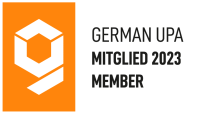The Design Process Straitjacket: How to Break Free And Embrace Creative Adaptability
20. September 2023 2023-09-28 10:25The Design Process Straitjacket: How to Break Free And Embrace Creative Adaptability

The Design Process Straitjacket: How to Break Free And Embrace Creative Adaptability
Creativity knows no bounds. It’s a realm where innovation flourishes, and ideas flow freely. Yet, within this infinite canvas, a limiting belief has quietly seeped into the minds of designers: “I must follow the design process step-by-step without deviation.”
At first glance, this belief might appear as a well-intentioned guide, a reliable roadmap through the complex design labyrinth. However, as we’ll soon discover, it can be more of a straitjacket than a guide, constraining creativity and stifling innovation.
This article sends you on a journey to liberate yourself from this belief, break free from the rigid constraints of design processes, and embrace the power of creative adaptability. It’ll delve into why this belief exists, its consequences, and most importantly, how to overcome it.
Are you ready to unleash your design potential? Let’s challenge the status quo and discover the boundless world of design creativity.

Understanding the Belief
To truly begin our quest for creative adaptability, we must first understand the belief that often holds us back – the notion that following a design process step-by-step, without deviation, is the path to success. Why is this belief so prevalent, and what are the implications for designers?
Defining the Belief: “Step by Step, No Deviation”
At its core, this belief manifests as a conviction that design should be a linear procedure, moving meticulously from one phase to another without veering off course. Whether following a well-known process like Design Thinking or a proprietary framework within your organisation, the idea is to adhere strictly to each step as if it were an unbreakable law.
Why Does This Belief Persist?
Recognising that this belief isn’t born out of ill intentions or a desire to stifle creativity is essential. Instead, it often emerges from a need for structure and a desire to ensure that critical aspects of the design process are not overlooked.
- Risk Aversion: One of the primary reasons behind this belief is the desire to mitigate risks. By following a predefined process, designers and organisations hope to reduce uncertainty and ensure critical steps aren’t skipped.
- Clarity and Communication: A standardised procedure can provide clarity and a common language for designers and stakeholders. It helps teams stay on the same page and fosters effective communication.
- Reproducibility: In some cases, strict adherence to a process is essential. This is particularly relevant in industries where safety and compliance are paramount, such as healthcare or aerospace.
- Education and Training: Design education often emphasises the importance of following processes to instil foundational skills and principles.
While these motivations are valid, the belief that rigid adherence to a process is the only path to success overlooks a crucial aspect of design – its inherently creative and iterative nature.

The Consequences of Rigidity
To understand creative adaptability, it’s essential to highlight the potential consequences of rigidly adhering to a predefined design process.
1. Stifling Innovation and Creativity
One of the most significant casualties of rigid design processes is innovation. Creativity flourishes when there’s room for exploration, experimentation, and the unexpected. Yet, when every process step is predefined, it can feel like creativity is confined within a box.
Consider this: some of the most groundbreaking design solutions emerged not from following established processes but from daring to step off the beaten path. Innovation is a competitive advantage; thus, stifling creativity can harm designers and the organisations they serve.
2. Missed Opportunities for Optimisation
Rigidity in design processes often means resistance to change, even when change is needed. Suppose a project encounters unexpected challenges or opportunities for improvement arise mid-process. In that case, a strict adherence to the original plan can prevent us from seizing these moments.
Imagine your team is tasked with designing a website for an e-commerce platform. The initial plan follows a well-established design process, outlining each phase from research to prototyping. Everything seems on track as the project unfolds step by step.
However, during the development phase, a sudden market shift occurs. A new trend emerges in e-commerce – a preference for interactive, personalised shopping experiences. Customers now expect real-time product recommendations and virtual try-on features, a departure from the static design initially envisioned.
In a flexible approach, your team can swiftly adapt to this market change. You can incorporate these interactive elements into the website’s design, aligning it with the evolving customer expectations. The result? A website that meets and exceeds customer needs sets your client apart in the competitive e-commerce landscape.
Now, consider the scenario with a rigid process. You’re bound by the predefined plan, and any deviation is discouraged. Despite the glaring shift in customer preferences, you must stick with the initial static design.
As a result, the website misses out on the opportunity to provide the interactive, personalised experience that customers now crave. By the time it launches, it’s already outdated, and the client is left with a less competitive product.
3. Frustration and Loss of Motivation
Designers are inherently creative individuals driven by a passion for solving problems and creating meaningful experiences. When forced into a rigid framework that prioritises process over creativity, frustration and burnout can set in. The tension between a designer’s creative instincts and the constraints of the process can be emotionally draining. The frustration that arises from such limitations can cast a shadow over the design journey, potentially leading to a loss of motivation and a significant decline in the quality of work produced. Design thrives when creativity flows freely, and the best solutions often emerge when designers are granted the freedom to explore, experiment, and innovate.
4. Ineffectiveness in Unique Scenarios
No two design projects are identical. Each comes with its distinct challenges, goals, and user needs. While a particular design process might excel in one context, it could be entirely unsuitable for another.
For example, a highly structured and time-consuming process like the double diamond model might be excellent for profoundly understanding user needs. Still, it might hinder progress in a fast-paced startup environment where rapid iteration is critical.
Unwavering adherence to a single process can lead to inefficiencies, missed deadlines, and subpar results.
As we reflect on these consequences, it becomes clear that adaptability and flexibility are not merely optional but essential qualities in the designer’s toolkit. They enable us to pivot when necessary, seize unexpected opportunities, and foster a culture of innovation and creativity.

Unveiling the Flexibility Factor
With an understanding of the limitations and consequences of rigidly following a design process, let’s dive into the concept of creative adaptability – the antidote to stifled creativity and missed opportunities. What exactly is creative adaptability, and why is it crucial in design?
Creative Adaptability Defined
Creative adaptability is the art of remaining open to change, nimble in approach, and responsive to the unique needs of each design challenge. It’s the willingness to embrace unpredictability as an opportunity rather than a hindrance.
In essence, creative adaptability recognises that the design process is not a one-size-fits-all endeavour. It acknowledges that while methods like Design Thinking, the double diamond, or Design Sprints offer valuable frameworks, they are tools to be wielded, not shackles to be worn.
Why Creative Adaptability Matters
- Meeting Evolving User Needs: In our fast-paced digital landscape, user needs evolve rapidly. What users expected yesterday may not align with their desires today. Creative adaptability enables designers to pivot swiftly and align their solutions with current user expectations.
- Navigating Ambiguity: Design challenges are rarely straightforward. Creative adaptability equips designers to navigate ambiguity with confidence. It allows them to experiment, test hypotheses, and refine their approach based on emerging insights.
- Fostering Innovation: True innovation often arises from the unexpected. By remaining adaptable, designers create space for unconventional ideas to flourish. They can explore uncharted territories and discover unique solutions that rigid processes might overlook.
- Optimising Resources: In a world where resources are often limited, adaptability becomes a resource-saving strategy. It prevents designers from investing time and effort in pursuits that no longer serve the project’s goals.
The Creative Adaptability Mindset
At the heart of creative adaptability lies a mindset shift. Designers and organisations must be willing to:
- Challenge Assumptions: Questioning the status quo and challenging assumptions is the first step. Recognise that a predefined process is a starting point, not a finish line.
- Embrace Uncertainty: Accept that design is inherently uncertain. Embrace this uncertainty as an opportunity for growth and discovery.
- Iterate Fearlessly: Creative adaptability thrives on iteration. Be open to refining your approach based on feedback, insights, and changing circumstances.
- Leverage Diverse Tools: Instead of being confined to a single process, consider a toolbox of methodologies and techniques. Choose the right tool for the specific challenge at hand.

Strategies for Overcoming the Belief
Now that we’ve established the importance of creative adaptability in design let’s delve into actionable strategies for designers to overcome the belief that they must follow a design process step-by-step without deviation. These strategies empower you to embrace adaptability while maintaining structure and purpose in your work.

1. Understand Your Unique Needs: Tailoring Starts with Insight
The journey towards adaptability begins with a deep understanding of your project’s unique needs. Here’s how to get started:
- Project Assessment: Take the time to assess your project thoroughly. What are the objectives? Who are the users? What are their pain points and goals? Understanding these aspects informs your design approach.
- Team Dynamics: Consider your team’s strengths and weaknesses. Are there diverse skill sets and perspectives you can leverage? How does your team’s dynamic influence the design process?
- Organisational Goals: Align your design process with your organisation’s overarching goals. What outcomes are you aiming to achieve? How can your design approach contribute to these objectives?
2. Leverage the Best Tools: Building Your Toolbox
Recognise that design methodologies are tools, not strict rules. Here’s how to select and integrate the right tools:
- Tool Selection: Choose design methodologies and techniques that align with your project’s goals and constraints. Consider Design Thinking, Design Sprints, Lean UX, or other frameworks based on your needs.
- Hybrid Approaches: Don’t hesitate to mix and match. Combine elements from various methodologies to create a tailored approach. For example, infuse aspects of Design Thinking into a Lean UX process for rapid problem-solving.
3. Iterate and Learn: Refinement Through Repetition
Adaptability thrives on iteration. Here’s how to integrate iterative practices into your design process:
- Continuous Feedback: Establish feedback loops within your team and with users. Regularly review and reflect on your progress. What’s working well, and where are there opportunities for improvement?
- Rapid Prototyping: Embrace rapid prototyping as a means of testing ideas quickly. Fail fast and learn from your mistakes. Each iteration brings you closer to a refined solution.
4. Embrace Cross-functional Collaboration: Fueling Creativity Through Diversity
Cross-functional collaboration is a cornerstone of adaptability. Here’s how to foster collaboration within your design process:
- Diverse Perspectives: Encourage collaboration with team members from various backgrounds and disciplines. Different viewpoints can lead to innovative solutions.
- Inclusive Ideation: Involve stakeholders in ideation sessions. Their insights can illuminate the problem’s critical aspects and potential solutions.
5. Document and Reflect: Nurturing Continuous Growth
Documentation and reflection ensure your adaptability efforts are purposeful and informed. Here’s how to incorporate these practices:
- Process Documentation: Keep records of your design process, decisions, and outcomes. This documentation provides a valuable reference and helps maintain consistency.
- Regular Review: Periodically review your documentation and reflect on your design journey. What lessons have you learned? How can you apply these insights to future projects?
By integrating these strategies into your design practice, you can overcome the belief in rigid adherence to processes. You’ll discover that adaptability and structure can coexist, leading to more innovative and user-centric design solutions.

Stories of Transformation
To truly grasp the power of creative adaptability, let’s explore the stories of designers who broke free from the belief that design processes must be followed rigidly and instead embraced adaptability. These tales of transformation are powerful reminders of the incredible outcomes that await those willing to pivot, innovate, and adapt.
Case Study 1: The Startup Sprint
For startups, speed is often paramount. A few weeks back, I talked to a team of designers embarking on a project for a young and ambitious startup. They found themselves faced with the challenge of delivering results swiftly. While Design Thinking was part of their usual toolkit, it felt too slow and cumbersome for the startup’s needs.
Their solution? A creative adaptation of the Design Sprint framework. Instead of strictly adhering to the Sprint’s rigid structure, they tailored it to match the startup’s unique challenges. They exchanged some exercises, emphasised rapid testing, and incorporated elements from Lean UX.
The result? A highly efficient, customised process that aligned perfectly with the startup’s pace and goals. This adaptability allowed them to iterate rapidly, make quick decisions, and ultimately launch a successful product ahead of schedule.
Case Study 2: The User-Centric Pivot
A seasoned UX designer I met two years ago and her team were tasked with a redesign project for their established e-commerce platform. They initially planned to follow a standard user-centred design process involving extensive user research, personas, and usability testing that was always used in the organisation.
However, as the project unfolded, unexpected user behaviour patterns emerged. The team recognised the need for a more flexible approach. Instead of adhering rigidly to the predefined process, they pivoted.
They shifted their focus towards iterative design and continuous user testing. This adaptability allowed them to address emerging issues promptly, refine their designs based on real user feedback, and create a more intuitive and user-friendly experience.
The redesign was a resounding success, resulting in increased user satisfaction and higher conversion rates. The adaptability to pivot when user insights demanded it was a game-changer.
Case Study 3: The Hybrid Innovation
A unique approach was adopted to foster adaptability in a design agency specialising in innovation where a friend of mine works. Instead of adhering strictly to a single design process, designers are encouraged to create hybrid methods that combine elements from various methodologies.
Teams select the most suitable components for each project from Design Thinking, Lean methods, and Agile practices. This adaptability allows them to tailor their approach to specific challenges, whether developing a new digital product or tackling a complex service design project.
The hybrid approach promotes creativity, flexibility, and collaboration. It ensures that no project is bound by rigid guidelines, allowing teams to adapt and innovate freely.
These case studies exemplify the transformative power of creative adaptability. By breaking free from the belief in rigid adherence to processes and instead embracing flexibility, these designers achieved remarkable results. They adapted their approaches to align with unique challenges, harnessed the full potential of their teams, and ultimately delivered exceptional user experiences.
As you reflect on these stories, consider how adaptability can empower your own design journey. Whether you’re in a startup environment, redesigning established platforms, or fostering innovation in a design agency, creative adaptability is a potent ally waiting to be embraced.

Conclusion
In design, where creativity knows no bounds, the belief that one must follow a design process step-by-step without deviation can feel like a straitjacket, constraining the very innovation that defines our field.
Through understanding the limitations of rigid processes, recognising the consequences of persistent adherence, and uncovering the true potential of adaptability, we’ve paved the way for transformation. We’ve explored practical strategies, from understanding unique project needs to embracing cross-functional collaboration, that empower us to adapt without losing our sense of purpose and structure.
Stories of designers who broke free from the process straitjacket have shown us the incredible results that await those willing to pivot, innovate, and adapt. From rapid startup sprints to user-centric pivots and hybrid approaches, these tales of transformation inspire us to be flexible in our thinking and methods.
Now, it’s your turn to embark on this journey. Embrace creative adaptability, and let it be your compass. Break free from the confines of rigid processes and discover the boundless possibilities of innovation and creativity.
Ready to take the next step? Book a free discovery call with me, and let’s explore how you can apply the principles of adaptability to your own design journey. Together, we’ll unlock your full potential, empowering you to create user-centric, innovative, and impactful designs that make a difference.
The path to creative adaptability awaits – are you ready to walk it?
Further Reading
AJ&Smart. How to Design Sprint. AJ&Smart. https://www.ajsmart.com/how-to-design-sprint
IDEO (n.d.). Design Thinking Defined. IDEO. https://designthinking.ideo.com/
Gothelf, J. (2023). Framework names don’t have to have baggage. Jeff Gothelf. https://jeffgothelf.com/blog/framework-names-dont-have-to-have-baggage/







